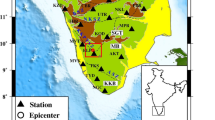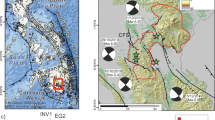Abstract
A moderate-size earthquake (Mw = 6.2) occurred on 3 February 2002 (07:11:28 GMT) in the Sultandağı-Çay region of southwest Turkey. The mainshock was followed by a strong aftershock of Mw = 6.0 just 2 h after the mainshock, at 09:26:49 GMT. A temporary seismic network of 27 vertical component seismometers was installed to monitor aftershock activity. One thousand sixty nine aftershocks (0.2 < ML < 3.3) were recorded during the period from 5 to 10 February 2002. We analyzed the P and S arrival times and P wave first motion data to obtain high-quality hypocenters and focal mechanisms, which revealed fine details of the fault zone. We infer that the mainshock has ruptured a segment of the Sultandağ Fault Zone that is approximately 37 km long and 7 km wide at depth. The average slip over the rupture plane during the mainshock is estimated to be 32 cm. The linear distribution of the aftershocks and the location of the mainshock epicenter suggest that rupture has initiated in the eastern bending of the fault and propagated unilaterally to the west. The majority of fault plane solutions indicate E–W to ESE–WNW striking oblique–normal faulting mechanisms with an average dip angle of 62° N ± 10° . The high-resolution aftershock seismicity image also shows that faulting involved a complex array of synthetic and possibly antithetic structures during the evolution of the aftershock sequence. The steady increase of the b value towards the west implies that the highest moment release of the mainshock occurred to the west of the epicenter. The study clearly shows the activation of the WNW–ESE-trending Sultandağ Fault Zone along the southern margin of the Akşehir-Afyon Graben (AAG). The westernmost end of the aftershock activity corresponds to a structurally complex zone distinct from the main rupture. It is characterized by both ENE–WSW- and NNE–SSW-trending oblique-slip normal faulting mechanisms, the latter being associated with the NNE–SSW-trending Karamık Graben. The intersection of these two grabens, AAG and Karamık Graben, provides abundant faults available for failure in this region. The occurrence pattern of large events in recent years indicates a possible migration of earthquakes from east to west. Thus, we conclude that this has an important implication for earthquake hazard for the city of Afyon, which lies along the same fault line and only 20 km west of the termination point of the aftershock zone.
Similar content being viewed by others
References
Aksarı D (2006) Analysis of 15 December 2000 and 3 February 2002 Sultandağı-Afyon earthquakes. MSc thesis, Boğaziçi University
Aktar M, Özalaybey S, Ergin M, Karabulut H, Bouin MP, Tapırdamaz C, Biçmen F, Yörük A, Bouchon M (2004) Spatial variation of aftershock activitiy across the rupture zone of the 17 August 1999 Izmit earthquake, Turkey. Tectonophysics 391:325–334. doi:10.11016/j.tecto.2004.07.020
Ambraseys NN (1988) Engineering seismology. Earthquake Eng Struct Dyn 17:1–105. doi:10.1002/eqe.4290170101
Barka A, Reilinger R, Şaroğlu F, Şengör AMC (1995) The İsparta Angle: its importance in the neotectonics of the Eastern Mediterranean Region. Proc Int Earth Sci Colloq Aegean Reg 1:3–18
Bozkurt E (2001) Neotectonics of Turkey—a synthesis. Geodin Acta 14:3–30. doi:10.1016/S0985-3111(01)01066-X
Boray A, Şaroğlu F, Emre Ö (1985) Isparta büklümünün kuzey kesiminde D-B daralma için bazı veriler. Jeoloji Mühendisliği. Dergisi 23:9–20 (in Turkish with English abstract)
Dumont JF (1976) The origin of Isparta Angle and Antalya nappes. General Directorate of Mineral Research and Exploration (MTA). Bulletin 86:56–57 (in Turkish with English abstract)
Emre Ö, Duman TY, Doğan A, Özalp S, Tokay F, Kuşçu İ (2003) Surface faulting associated with the Sultandağı earthquake (Mw 6.5) of 3 February 2002, Southwestern Turkey. Seismol Res Lett 74:382–392
Eyidoğan H, Güçlü U, Utku Z, Degirmenci E (1991) Türkiye büyük depremleri makrosismik rehberi (1900–1988) Macroseismic catalogue of largest earthquakes of Turkey (1900–1988). Istanbul Technical University, Faculty of Mines, Department of Geophysical Engineering Publication (in Turkish)
Glover C, Robertson AD (1998) Neotectonic intersection of the Aegean and Cyprus tectonic arcs: extensional and strike-slip faulting in the Isparta Angel, SW Turkey. Tectonophysics 298:103–132. doi:10.1016/S0040-1951(98)00180-2
Jackson JA, McKenzie DP (1984) Active tectonics of the Alpine–Himalayan Belt between western Turkey and Pakistan. Geophys J R Astron Soc 77:185–246
Kiratzi A, Louvari E (2003) Focal mechanisms of shallow earthquakes in the Aegean Sea and the surrounding lands determined by the waveform modeling: a new database. J Geodyn 36:251–274. doi:10.1016/S0264-3707(03)00050-4
Kissling E, Ellsworth WL, Eberhart D, Kradolfer U (1994) Initials reference models in local earthquake tomography. J Geophys Res 99:19,635–19,646. doi:10.1029/93JB03138
Kissling E, Ellsworth WL, Eberhart D, Kradolfer U, Maurer H (1995) VELEST user’s guide—short introduction. Tech rep, Institute of Geophysic and Swiss Seismological Service, ETH-Zurich
Koçyiğit A (1984) Güneybatı Türkiye ve yakın dolayında levhaiçi yeni tektonik gelişim. Geol Soc Turk Bull 27:1–16
Koçyiğit A, Özacar AA (2003) Extensional neotectonic regime through the NE edge of the Outer Isparta Angle, SW Turkey: new field and seismic data. Turk J Eart Sci 12:67–90
Koçyiğit A, Ünay E, Saraç G (2000) Episodic graben formation and extensional neptectonic regime in west Central Anatolia and Isparta Angle: a case study in the Akşehir-Afyon Graben, Turkey. In: Bozkurt E, Winchester JA, Piper JDA (eds) Tectonics and magmatism in Turkey and the surrounding area. Special Publications, vol 173. Geological Society, London, pp 405–421
Lienert BR, Berg E, Frazer LN (1986) Hypocenter: an earthquake location method using centered, scaled, and adaptively damped least squares. Bull Seismol Soc Am 76:771–783
McKenzie DP (1972) Active tectonics of the Mediterranean region. Geophys J R Astron Soc 30(2):109–185
McKenzie DP (1978) Active tectonics of the Alpine Himalayan belt; the Aegean Sea and surrounding regions (tectonics of Aegean region). Geophys J R Astron Soc 55:217–254
Ozer N (2006) New information on earthquake history of the Aksehir-Afyon Graben System, Turkey, since the second half of 18th century. Nat Hazards Earth Syst Sci 6:1017–1023
Reasanberg PA, Oppenheimer DH (1985) FPFIT, FPPLOT and FPPAGE: Fortran computer programs for calculating and displaying earthquake fault-plane solutions. US Geol Surv Open File Rep 85–739, 109 pp
Rivera L, Cisternas A (1990) Stress tensor and fault plane solutions for a population of earthquakes. Bull Seismol Soc Am 80(3):600–614
Roumelioti Z, Kiratzi A, Benetatos C, Aktar M, Karabulut H, Theodulis G, Örgülü G (2004) Source process of normal earthquakes, the 3 February 2002, M = 6.3, Afyon Turkey and the 7 September 1999, M = 5.9 Athens Greece earthquakes. In: Proc of fifth international conference on case histories on geotechnical engineering, New York, 2004, pp 1–8
Somerville P, Irikura K, Graves KR, Sawada S, Wald D, Abrahamson N, Iwasaki Y, Kagawa T, Smith N, Kowada A (1999) Characterizing crustal earthquake slip models for the prediction of strong ground motion. Seismol Res Lett 70:59–80
Şaroğlu F, Emre Ö, Boray A (1987) Türkiye’nin Diri Fayları ve Depremselliği Mineral Research and Exploration Institute of Turkey (MTA) Report no. 8174
Şaroğlu F, Emre Ö, Kuşçu İ (1992) Active fault map of Turkey. Mineral Research and Exploration Institute of Turkey (MTA) Pub
Tan O, Tapırdamaz MC, Yörük A (2008) The earthquake catalogues for Turkey. Turk J Earth Sci 17:405–418
Tapırdamaz MC, Tarancıoğlu A, Özalaybey S, Ergin M, Selvi O, Yörük A, Biçmen F, Aktar M (2002) Sultandağı (Afyon) Depremi (03 Şubat 2002, Mw = 6.2) Artçı Deprem Çalışması. Aktif Tektonik Araştırma Grubu Altıncı Toplantısı (ATAG-6), Ankara, pp 34–41 (in Turkish)
Taymaz T, Prize S (1992) The 1971 May 12 Burdur earthquake sequence SW-Turkey a synthesis of seismological ang geological observations. Geophys J Int 108:589–603. doi:10.1111/j.1365-246X.1992.tb04638.x
Taymaz T, Tan O (2001) Source parameters of June 6, 2000 Orta-Çankırı (Mw = 6.0) and December 15, 2000 Sultandağ-Akşehir (Mw = 6.0) earthquakes obtained from inversion of teleseismic P- and SH- body-waveforms. In: Scientific activities 2001 symposia, Istanbul Technical University the Faculty of Mines, Extended Abstracts, Istanbul, 8 May 2001, pp 96–107
Taymaz T, Jackson JA, McKenzie D (1991) Active tectonics of the North and Central Aegean Sea. Geophys J Int 106:433–490. doi:10.1111/j.1365-246X.1991.tb03906.x
Taymaz T, Tan O, Özalaybey S, Karabulut H (2002) Source characteristics of February 3, 2002 Çay-Sultandağı earthquake (Mw = 6.5) sequence in SW Turkey: a synthesis of seismological obsevations body-waveforms, strong motion, and aftershock seismicity survey data. In: 1st international symposium of Istanbul Technical University the Faculty of Mines on Earth Sciences and Engineering, Abstracts, Istanbul, 16–18 May 2002, p 60
Ulusay R, Aydan Ö, Erken A, Tuncay E, Kumsar H, Kaya Z (2004) An overview of geotechnical aspects of the Çay-Eber (Turkey) earthquake. Eng Geol 73:51–70. doi:10.1016/j.enggeo.2003.11.005
Westaway R (1994) Present-day kinematics of the Middle East and eastern Mediterranean. J Geophys Res 99:12,071–12,090. doi:10.1029/94JB00335
Wiemer S, Katsumata K (1999) Spatial variability of seismicity parameters in aftershock zones. J Geophys Res 104:13135–13151. doi:10.1029/1999JB900032
Wiemer S, Zuniga RF (1994) ZMAP a software package to analyze seismicity. EOS, Trans AGU, Fall Meeting Suppl 75:456
Wyss M, Schorlemmer D, Wiemer S (2000) Mapping asperities by minima of local recurrence time: the Sun Jacinto–Elsinore fault zones. J Geophys Res 105:7829–7844. doi:10.1029/1999JB900347
Yılmaz Y, Şaroğlu F, Güner Y (1987) Initiation of the neomagmatism in East Anatolia. Tectonophysics 134:177–199. doi:10.1016/0040-1951(87)90256-3
Author information
Authors and Affiliations
Corresponding author
Rights and permissions
About this article
Cite this article
Ergin, M., Aktar, M., Özalaybey, S. et al. A high-resolution aftershock seismicity image of the 2002 Sultandaği-Çay earthquake (Mw = 6.2), Turkey. J Seismol 13, 633–646 (2009). https://doi.org/10.1007/s10950-009-9155-1
Received:
Accepted:
Published:
Issue Date:
DOI: https://doi.org/10.1007/s10950-009-9155-1




